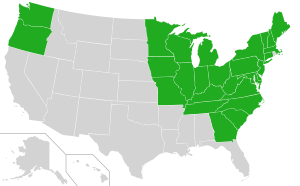Crimson beebalm facts for kids
Quick facts for kids Crimson beebalm |
|
|---|---|
 |
|
| Flower being visited by a hummingbird | |
| Scientific classification | |
| Genus: |
Monarda
|
| Species: |
didyma
|
 |
|
| U.S. distribution of Monarda didyma | |
Monarda didyma, also known as Crimson Beebalm or Oswego Tea, is a beautiful and fragrant plant. It's a type of herb that belongs to the mint family, called Lamiaceae. You can find it growing naturally in eastern North America. This includes places from Maine in the east, all the way to Ontario and Minnesota in the west. It also grows south into northern Georgia.
Many people think its smell is a lot like the bergamot orange. This is the fruit used to give Earl Grey tea its special flavor. The plant's scientific name, Monarda, honors Nicolas Monardes. He was a person who wrote about American plants back in 1569.
Contents
What is Crimson Beebalm?
Crimson Beebalm is a tough plant that comes back every year. This means it's a perennial. It can grow quite tall, usually between 0.7 to 1.5 meters (about 2 to 5 feet) high. Its stems are square-shaped.
The leaves grow in pairs on the stems. They are about 6 to 15 centimeters (2.5 to 6 inches) long. They are dark green with reddish veins. The edges of the leaves are a bit jagged, like tiny teeth.
The plant has bright red, tube-shaped flowers. They are about 3 to 4 centimeters (1 to 1.5 inches) long. These flowers grow in big, showy clusters, with about 30 flowers in each group. They also have reddish leaves called bracts around them. You can often see these plants growing in thick groups. They like to be near stream banks and ditches. They usually bloom from the middle to the end of summer.
Who Likes Beebalm?
This plant is very popular with hummingbirds. They love to visit its bright red flowers. It's also a special plant for some insects. It provides a home for the young (larvae) of certain moths. These include the hermit sphinx, orange mint moth, and the raspberry pyrausta.
Growing and Using Beebalm
Crimson Beebalm is a very popular plant to grow in gardens. People plant it for its beauty, both in its native areas and in other parts of the world. It has even started growing on its own in some parts of the United States, Europe, and Asia.
This plant grows best in sunny spots. However, it can also handle a little bit of shade. It likes soil that is moist but also drains water well. There are many different types of Beebalm you can grow. They have flowers in various colors, from white and pink to dark red and purple.
Traditional Uses of Beebalm
Beebalm has been used for a very long time as a medicinal plant. Many Native Americans used it for its healing properties. For example, the Blackfoot people knew that this plant had strong antiseptic qualities. An antiseptic helps to stop germs from growing.
They would make a paste from the plant. This paste was used on skin infections and small wounds. It helped to clean them and prevent further problems. They also made an herbal tea from the plant. This tea was used to help with mouth and throat infections. These infections could be caused by tooth decay or gingivitis (gum inflammation).
Beebalm naturally contains a substance called thymol. This is the main active ingredient found in many modern mouthwashes. It's what helps to kill germs. The Winnebago people also made an herbal tea from beebalm. They used it to feel more energetic. Native Americans also used it to help with too much gas in the stomach. The Native Americans living in Oswego, New York, made tea from the leaves. This is why one of its common names is Oswego Tea.
Images for kids



